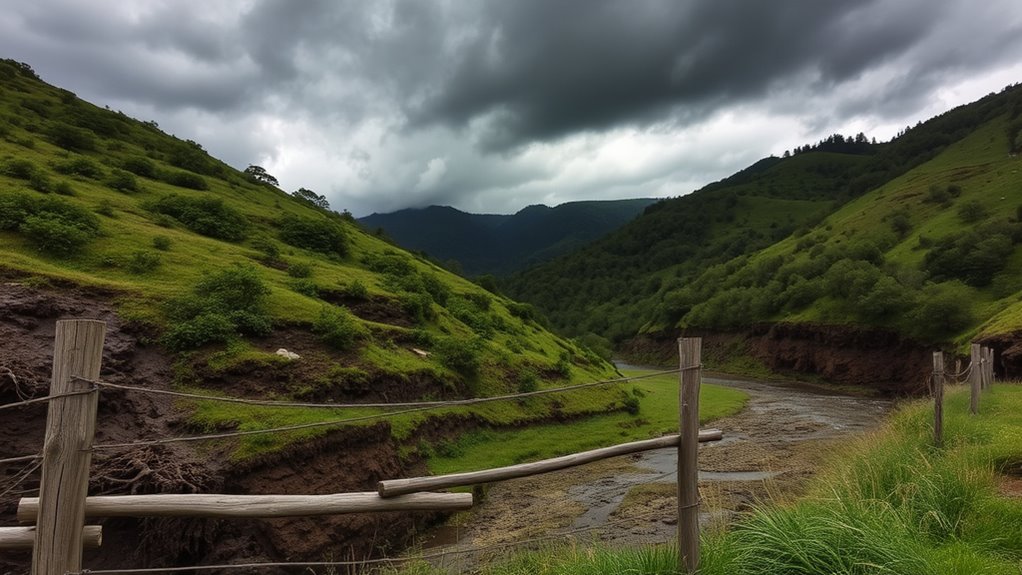In Appalachia, the arrival of spring rains greatly boosts landslide risks. Heavy rainfall can trigger debris flows and multiple landslides on steep slopes. This risk is compounded by logging activities that destabilize soil. As the ground saturates, the potential for erosion increases, leading to dangerous conditions. It’s crucial to monitor weather patterns and maintain natural drainage to reduce these hazards. There’s more to understand about the factors and strategies that can mitigate these dangers.
Key Takeaways
- Spring in Appalachia sees heightened landslide risks due to heavy rainfall events, leading to increased debris flows and soil destabilization.
- The removal of trees during logging activities exacerbates landslide risks by destabilizing soil and increasing erosion potential.
- Geological factors, including steep slopes and unique geology, contribute to the frequency and types of landslides experienced in the region.
- Effective stormwater management and monitoring systems are crucial for mitigating water flow impacts on vulnerable slopes during spring rains.
- Community education about landslide risks can empower residents to take precautionary measures during high-risk periods in the spring.

Landslides pose a considerable risk in Appalachia, especially during heavy rainfall events that can occur in spring and late summer. As you navigate this beautiful mountainous region, it’s essential to be aware of the types of landslides that can occur, particularly debris flows triggered by heavy rains. These flows often happen during spring storms or the remnants of late summer tropical cyclones, posing a danger to both residents and visitors alike.
You should know that multiple failures can occur, where clusters of small landslides and debris flows happen in quick succession, leading to even more considerable issues. Although lateral spreads are rare, they involve the movement of large rock blocks and can be equally hazardous. The heavy rainfall, particularly from cloudbursts and thunderstorms, is the primary trigger for these landslides, combined with the steep slopes that characterize the Appalachian terrain.
Logging activities can severely exacerbate the risk of landslides. In logged areas, you might see landslides occurring up to nine times more frequently due to soil destabilization from the removal of tree roots. Trees play a critical role in absorbing water and maintaining soil stability, so their absence can considerably increase vulnerability to erosion and landslides. Maintaining natural drainage paths is essential to mitigate these risks, as altered water flow can lead to catastrophic events.
Spring is particularly risky due to heavy rains, but it’s important not to overlook late summer storms and even autumn’s heavy rainfall. While winter conditions are generally less prone to landslides, year-round monitoring is essential, given the potential for unexpected rainfall events.
Regions like central and southern Appalachia are especially susceptible to landslides due to their unique geology and steep slopes. The extensive area from Pennsylvania to Alabama experiences debris flows more critically triggered by intense rainfall rather than the total amount. The geological variability across these regions influences the types and frequencies of landslides, making it essential for you to stay informed.
To mitigate these risks, nature-based solutions and proper logging practices can stabilize slopes. Effective stormwater management and monitoring systems help reduce the impact of water flow, while community education about landslide risks can empower individuals to take precautions.
Frequently Asked Questions
What Are the Warning Signs of a Potential Landslide?
To identify warning signs of a potential landslide, look for increased soil saturation, unusual water flow, and sudden changes in creek levels.
You might notice bulging soil, new cracks in paved areas, or leaning trees and fences.
Watch for doors sticking or new cracks in walls.
Listen for strange sounds like cracking or rumbling, and pay attention to changes in wildlife behavior or vegetation patterns around you.
How Can I Prepare My Home for Landslide Risks?
Landslide readiness requires rigorous research and proactive precautions.
Start by securing your slope with sturdy ground covers and building robust retaining walls. Redirect runoff away from vulnerable areas, and consult local experts for an assessment.
Keep an eye out for warning signs like cracks and shifting structures. Don’t forget to devise an emergency escape plan, stock up on supplies, and stay alert during storms to protect your home from potential landslide dangers.
Are There Specific Areas in Appalachia More Prone to Landslides?
Yes, some areas in Appalachia are definitely more prone to landslides.
Regions with steep slopes and shallow soils, particularly in parts of West Virginia and Virginia, have higher risks. You should pay attention to red zones on landslide maps, which indicate areas with significant susceptibility.
Local geology and recent weather patterns can also influence specific risks, so staying informed about your area’s conditions is key to understanding potential landslide threats.
What Should I Do During a Landslide Emergency?
During a landslide emergency, you need to evacuate immediately if you receive an alert or notice warning signs.
If you’re indoors, take cover under sturdy furniture. If you’re outside, run to high ground away from the landslide path.
If escape isn’t possible, curl into a ball to protect your head. Always avoid debris and unstable areas.
Staying calm and acting quickly can make a significant difference in your safety during such an event.
How Is Climate Change Affecting Landslide Frequency in Appalachia?
Climate change’s effects on landslide frequency in Appalachia feel like a ticking clock, with each tick bringing more rain and risk.
You’re witnessing more intense storms, leading to increased shallow landslides that can sweep through communities rapidly.
The changes in rainfall patterns mean more localized downpours, heightening the dangers.
As these events become commonplace, your awareness and preparation become essential to safeguarding your community and well-being against this looming threat.
Conclusion
As spring rains arrive in Appalachia, the risk of landslides becomes a pressing concern for everyone living in the region. It’s vital to stay informed and prepared, as the earth can shift unexpectedly, putting lives and property at risk. Are we doing enough to protect our communities from these natural threats? By working together and prioritizing safety measures, we can mitigate these risks and guarantee a safer environment for ourselves and future generations.










